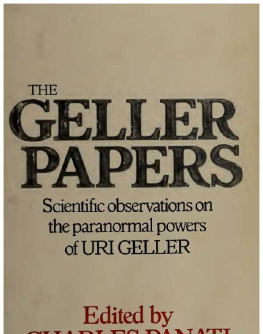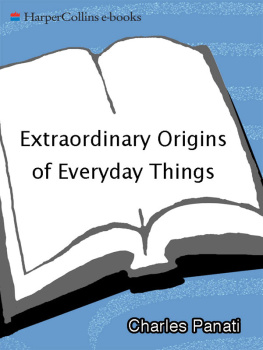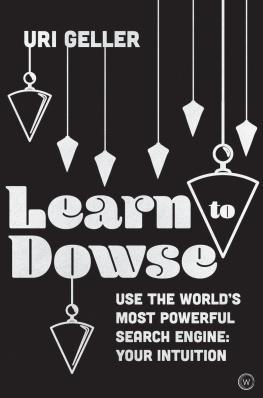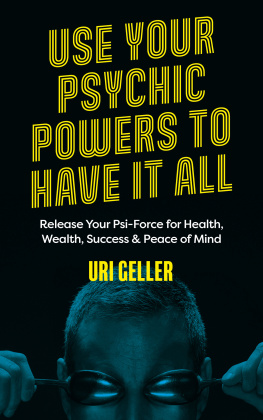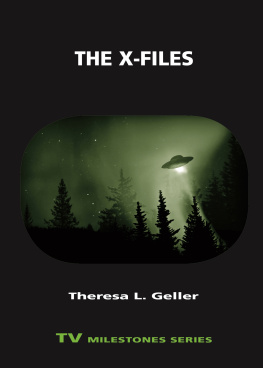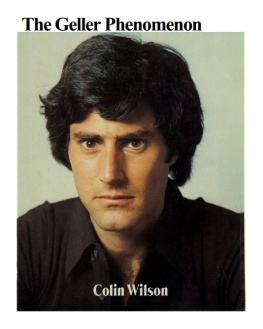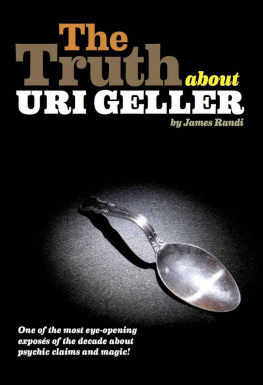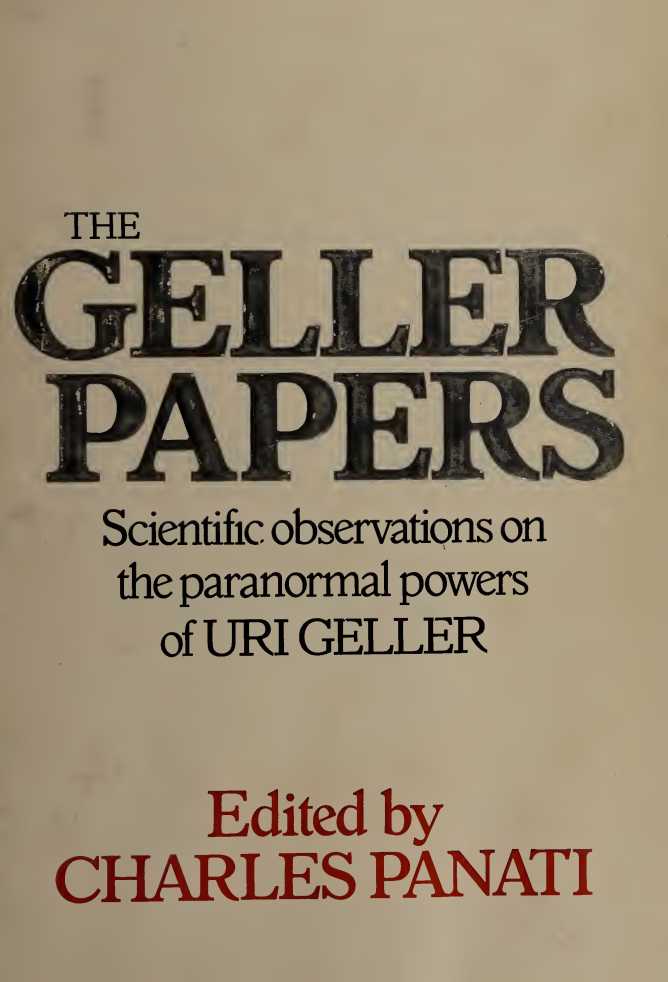Copyright 1976 by Charles Panati. All rights reserved. No part of this work may be reproduced or transmitted in any form by any means, electronic or mechanical, including photocopying and recording, or by any information storage or retrieval system, without permission in writing from the publisher.
Library of Congress Cataloging in Publication Data
Main entry under title: The Geller papers.
Includes bibliographies. 1. Geller, Uri, date Addresses, essays, lectures.
I. Panati, Charles, date PF 1283.G4G44 76-3701
ISBN 0-395-24351-3
Printed in the United States of America c 10 987654321
PREFACE
There has been much debate in the last few years over the powers or, as some prefer to say, prestidigitations of the thirty-year-old Israeli Uri Geller. Can he bend metal by gently stroking it or not touching it at all? Can he clairvoyantly see the uppermost face of a die that has been shaken in a sealed metal box before the lid of the box is opened? Can he telepathically read the thoughts of others?
A growing number of professionals, most notably physical scientists, believe Geller can do these things. They have tested him. They have observed events for which there are no present scientific explanations. Other people, however, among them magicians, see Geller as tremendously talented, lightning-fast in his deceptions, and disarmingly humble over his many failures. They take him to task not because of his talent and theatrics, but because, according to them, he pawns off what he does as the real thing the product of innate paranormal abilities.
The purpose of this book is to present firsthand observations on the talents of Uri Geller and, in doing so, to bring to light and offer for public scrutiny much material that has either never before appeared in print or has surfaced only piecemeal in the popular press. The book is written through papers, reports, diary entries, and letters by the scientists and professionals who, in various ways, have scrutinized Gellers talents, and feel that Geller is an individual who deserves further scientific attention.
Since 1972, when he first came to worldwide attention, Geller has been tested in seventeen laboratories in eight different countries. The scientists who have worked with him have watched him deform solid steel rods without touching them, cause part of an exotic crystal to vanish from within a sealed container, alter the memory of a rare metal alloy, erase information from computer tapes, set Geiger counters ticking with only his thoughts, and read the thoughts of others while he is sealed in a room that blocks out all types of radio waves. They are men and women of probity, affiliated with major universities and research centers throughout the world. To prevent fraud the scientists have searched Geller for metals that might be hidden under his fingernails and magnets sewn into his clothing, x-rayed his teeth for evidence of minute electronic devices, bound his hands, blindfolded his eyes, all but stripped him naked. Many of the scientists flatly stake their reputation on the genuineness of Gellers paranormal talents.
But scientists, it is rightfully said, should not be the final arbiters in separating what is psychic from what is magic. And they have not been. Four magicians have worked closely with Geller, applied their own standards to prevent any sleight of hand, and have observed inexplicable events. It is their unanimous opinion that Geller either has paranormal abilities or is acquainted with a form of magic unknown to the entire brotherhood of magicians. Their observations are presented here along with those of the scientists.
Some of the papers in this book were originally meant for publication in reputable scientific journals and several were submitted to these journals. In each case it was the scientists hope that publication of his work with Geller would provide a platform for healthful debate and would generate further and more exhaustive experimentation. To date, however, only one paper has appeared in a major scientific journal. It is not the purpose of this preface to examine the procedures of scientific publishing, least of all for such a highly unorthodox subject as parapsychology. Suffice it to say that all of those papers appear here. No material in them has been altered; no terminology diluted; the reports contain all the original charts, diagrams, pictures, and references that support the research. Gellers failures as well as his successes are discussed.
Some of the papers are heavily detailed, giving all the specifics necessary for a scientific investigation. Others are short sketches, informal notes, or personal observations about the hours and days a particular researcher spent with Geller. Fourteen papers are by physicists, mathematicians, and engineers; three by parapsychologists; four by magicians; one by a professional photographer (who witnessed Geller take a thought photograph); and one (a letter that appears in the Introduction) by a dentist who x-rayed Gellers mouth for evidence of hidden devices. These men and women who have tested Geller are convinced that he is a phenomenon worthy of, indeed, demanding, the serious attention of science. As the prestigious British technical journal Nature editorialized, Geller has clearly created a prima facie case for further investigation.
Who are the professionals who have investigated Geller? What are their credentials? How rigorous or casual were their investigations? Exactly what did they do? And, of course, what did they discover? These questions will be examined, in part, in the Introduction. It should be noted, however, that the Introduction is not meant to be an evaluation of the papers; the papers stand or fall on their own contents. Rather, because of the technical nature of many of the papers and the sheer volume of the material they contain, the Introduction will serve as a general review, for the layman, of the major highlights of the research that has been done with Geller.
There can be no doubt that this research will affect different people in radically different manners. Geller-advocates who read this collection of firsthand observations may feel confirmed in their present opinion of him. His critics will dissect these papers and will find large loopholes and countless faults with the experiments and descriptions they contain, for all of the evidence presented here is certainly not of equal quality. There is nevertheless a considerable amount of new and impressive information from responsible scientists and professional magicians alike. Their observations taken as a whole are hard to dismiss on the grounds of simple fraud or mass delusion. But whatever ones opinion of the events described in this book, the thoughtful reader should give these reports a careful review before drawing final conclusions on the phenomena associated with Uri Geller.
CONTENTS
Metal fracture physics using scanning electron microscopy and the theory of teleneural interactions. Wilbur Franklin, Ph.D., Department of Physics, Kent State University, Kent, Ohio.
Uris Magic. Thelma Moss, Ph.D., The Neuropsychiatri Institute, Center for the Health Sciences, University of California at Los Angeles.
Magnetic pattern erasure: a proposed method of scientific study. Ronald S. Hawke, Lawrence Livermore Laboratory, Livermore, California.
Filmed and nonfilmed events: on Uri Gellers visit to Western Kentucky University. Thomas P. Coohill, Ph.D., Physics Department, Western Kentucky University, Bowling Green, Kentucky.
A preliminary scrutiny of Uri Geller. William E. Cox, The Institute for Parapsychology, Foundation for Research on the Nature of Man, Durham, North Carolina.

